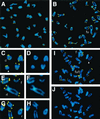DNA strand break-sensing molecule poly(ADP-Ribose) polymerase cooperates with p53 in telomere function, chromosome stability, and tumor suppression
- PMID: 11359911
- PMCID: PMC87066
- DOI: 10.1128/MCB.21.12.4046-4054.2001
DNA strand break-sensing molecule poly(ADP-Ribose) polymerase cooperates with p53 in telomere function, chromosome stability, and tumor suppression
Abstract
Genomic instability is often caused by mutations in genes that are involved in DNA repair and/or cell cycle checkpoints, and it plays an important role in tumorigenesis. Poly(ADP-ribose) polymerase (PARP) is a DNA strand break-sensing molecule that is involved in the response to DNA damage and the maintenance of telomere function and genomic stability. We report here that, compared to single-mutant cells, PARP and p53 double-mutant cells exhibit many severe chromosome aberrations, including a high degree of aneuploidy, fragmentations, and end-to-end fusions, which may be attributable to telomere dysfunction. While PARP(-/-) cells showed telomere shortening and p53(-/-) cells showed normal telomere length, inactivation of PARP in p53(-/-) cells surprisingly resulted in very long and heterogeneous telomeres, suggesting a functional interplay between PARP and p53 at the telomeres. Strikingly, PARP deficiency widens the tumor spectrum in mice deficient in p53, resulting in a high frequency of carcinomas in the mammary gland, lung, prostate, and skin, as well as brain tumors, reminiscent of Li-Fraumeni syndrome in humans. The enhanced tumorigenesis is likely to be caused by PARP deficiency, which facilitates the loss of function of tumor suppressor genes as demonstrated by a high rate of loss of heterozygosity at the p53 locus in these tumors. These results indicate that PARP and p53 interact to maintain genome integrity and identify PARP as a cofactor for suppressing tumorigenesis.
Figures





References
-
- Agarwal M L, Agarwal A, Taylor W R, Wang Z-Q, Wagner E F, Stark G R. Defective induction but normal activation and function of p53 in mouse cells lacking poly-ADP-ribose polymerase. Oncogene. 1997;15:1035–1041. - PubMed
-
- Artandi S E, Chang S, Lee S L, Alson S, Gottlieb G J, Chin L, DePinho R A. Telomere dysfunction promotes non-reciprocal translocations and epithelial cancers in mice. Nature. 2000;406:641–645. - PubMed
-
- Banin S, Moyal L, Shieh S, Taya Y, Anderson C W, Chessa L, Smorodinsky N I, Prives C, Reiss Y, Shiloh Y, Ziv Y. Enhanced phosphorylation of p53 by ATM in response to DNA damage. Science. 1998;281:1674–1677. - PubMed
-
- Bell D W, Varley J M, Szydlo T E, Kang D H, Wahrer D C, Shanon K E, Lubratovich M, Verselis S J, Issebacher K J, Fraumeni J F, Birch J M, Li F P, Garber J E, Haber D A. Heterozygous germ line hCHK2 mutations in Li-Fraumeni syndrome. Science. 1999;286:2528–2531. - PubMed
-
- Blackburn E H. Telomere states and cell fates. Nature. 2000;408:53–56. - PubMed
Publication types
MeSH terms
Substances
Grants and funding
LinkOut - more resources
Full Text Sources
Molecular Biology Databases
Research Materials
Miscellaneous
